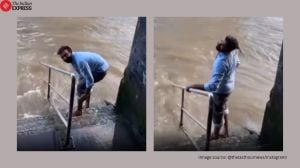19 die in latest Nepal air crash,safety fears mount
The accident involving the Sita Air plane had been caused by a bird-hit.
SIXTEEN passengers and three crew members on board a Dornier aircraft bound for Lukla in the Mt Everest area were killed Friday as the plane crash-landed on the bank of a river barely two minutes after taking off from the Kathmandu airport.
Civil aviation department officials said the accident involving the Sita Air plane had been caused by a bird-hit. There were seven Britons,five Chinese and seven Nepalis including the crew on board the plane which took off around 6.30 am and came down on the bank of the Manohara river barely 3 km away and caught fire.
Fridays accident was caused by bird-hit and the pilot made all attempts for a safe landing, Ratish Chandra Lal Suman,general manager of Tribhuvan International Airport,told reporters. The air traffic control had warned the pilot that an unusual manoeuvering of the aircraft had been noticed at the time of take-off. An apparent attempt to turn back at a low height is being seen as the possible cause.
Lukla is the nearest airport to the Mt Everest base camp and is popular among Western tourists who come to Nepal to trek. This is the second plane accident in Nepal in four months. Fifteen people,including 11 Indians,were killed in May when their plane crashed into a hill in Jomsom near the Nepal-Tibet border.
There is growing concern about Nepals poor aviation safety record,particularly among foreign tourists,and experts blame this on the Himalayan nations poor regulatory systems.
Nepals 63-year-old civil aviation sector has recorded 730 deaths but major accidents involving fatalities have taken place over the last 46 years involving about 74 crashes. Fridays crash was the third major accident in 12 months and the eighth in two years.
But officials say that the number of accidents in proportion to the increase in the volume of services and number of aircraft in operation is not alarming. They,however,admit that regulatory mechanisms and enforcement of safety measures are generally left to the airlines – mostly private – with no system of accountability in place. The government does not allow import of aircraft that are older than 15 years but those already in operation have been around for longer. The International Civil Aviation Organisation had in its 2010 annual report warned Nepal that its skies were not safe going by the number of accidents.
In 99 per cent cases,human errors have caused accidents, Vijay Shrestha,Group Executive Director of the private Yeti Airlines which has the highest number of planes in Nepal,told The Indian Express. Not that they are not competent,but some improvement in their attitude and approach will make our airways much safer.
But senior pilots working for domestic and international airlines and familiar with Nepals safety standards blame it on corruption. The nexus between civil aviation officials and some private airlines and the negligence in monitoring regular checks of aircraft are the main cause of accidents,they allege.
The fact that barring two accidents – involving a Thai Airways plane in July 1992 and a PIA plane within two months of that,which together killed 280 people – all others have involved the countrys domestic services reflects the high level of negligence and corruption,they alleged.
But some others who have been involved with the sector sought to play down the safety fears. We can blame many factors. But we should not exaggerate the safety factor. Given the volume of air traffic,the number of accidents is neither alarming nor unusual, said Mohan Chandra Singh,former deputy general manager of Tribhuvan airport who was involved in many investigations in the past.
Private airline operators claim they get their aircraft checked regularly as prescribed and their pilots too undergo regular simulator training courses.



- 01
- 02
- 03
- 04
- 05




























